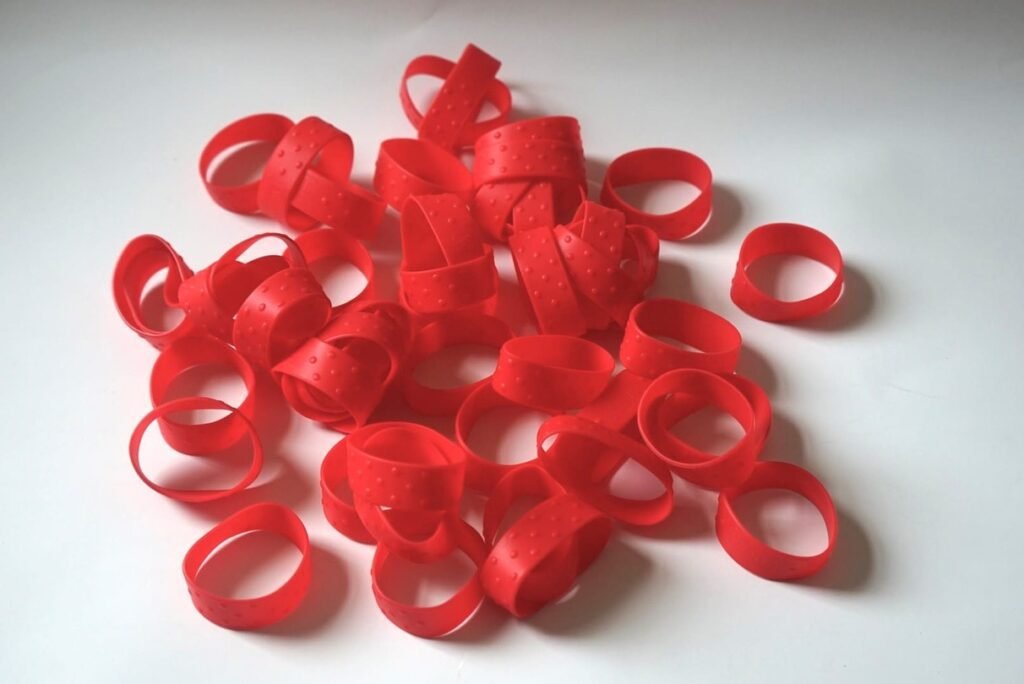Rubber bands are versatile and widely used elastic loops made from rubber material. They play an essential role in various everyday applications due to their stretchability and resilience.

Here, we'll explore how rubber bands are made.
Main Steps :
- Raw Material Collection
- Preparing the Latex
- Extruding the Rubber Tubes
- Curing and Hardening
- Cutting into Bands
- Quality Inspection
- Packaging and Distribution
Composition and Material: Rubber bands are typically made from natural rubber or synthetic rubber compounds. Natural rubber bands are derived from latex, which is extracted from rubber trees. Synthetic rubber bands, on the other hand, are produced from various polymers like neoprene, silicone, and EPDM (ethylene propylene diene monomer).
Manufacturing Process: The manufacturing process of rubber bands involves several key steps:
- Raw Material Selection: The choice of rubber material, whether natural or synthetic, depends on the desired characteristics of the rubber bands, such as elasticity, strength, and temperature resistance.
- Extrusion: The selected rubber material is fed into an extruder, where it is heated and forced through a die to create long cylindrical shapes known as rubber tubes.
- Curing: The rubber tubes are then vulcanized or cured by subjecting them to heat and chemical treatments. This process enhances their elasticity and durability.
- Cutting: After curing, the rubber tubes are cut into individual rubber bands of the desired size and thickness. Precision is crucial to ensure uniformity.
- Quality Control: Quality control measures are implemented to check for defects, ensuring that the rubber bands meet specific standards.
Common Uses: Rubber bands find a multitude of uses in various industries and everyday life, including:
- Office Supplies: They are commonly used to bundle documents, papers, and envelopes together.
- Packaging: Rubber bands are used in packaging to secure items and prevent them from shifting or opening during transit.
- Crafts and Hobbies: They are popular in crafting projects, such as making bracelets and other DIY creations.
- Musical Instruments: Rubber bands can be used as makeshift instrument strings or dampeners in some musical applications.
- Medical and Dental: In the medical field, rubber bands are used in orthodontics for braces adjustments and in laboratories for securing test tubes.
- Industrial Applications: Rubber bands are used in industrial settings for various purposes, including securing items on pallets and bundling wires and cables.
Elasticity and Stretchability: The unique property of rubber bands is their elasticity, allowing them to stretch significantly and return to their original shape. This elasticity is due to the molecular structure of rubber, which consists of long polymer chains that can be stretched and retracted. When a rubber band is stretched, the polymer chains extend, and when released, they contract, causing the band to recoil.
Conclusion:
Rubber bands may seem simple, but their utility and versatility make them indispensable in countless situations. Whether you're bundling paperwork, crafting, or using them in specialized applications, these small elastic loops are a testament to the remarkable properties of rubber and the ingenuity of their design and manufacturing process.
If you're in need of rubber bands or have questions about rubber products, don't hesitate to contact Julong Rubber for expert assistance.








